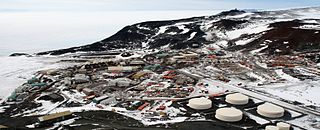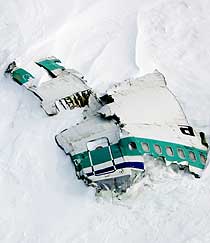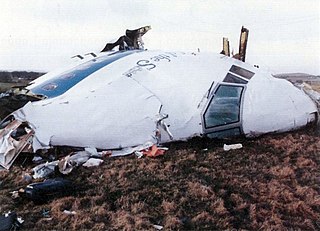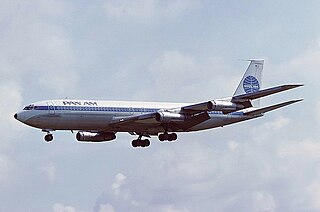
The history of Antarctica emerges from early Western theories of a vast continent, known as Terra Australis, believed to exist in the far south of the globe. The term Antarctic, referring to the opposite of the Arctic Circle, was coined by Marinus of Tyre in the 2nd century AD.

Pan American World Airways, originally founded as Pan American Airways and commonly known as Pan Am, was an American airline that was the principal and largest international air carrier and unofficial overseas flag carrier of the United States for much of the 20th century. It was the first airline to fly worldwide and pioneered numerous innovations of the modern airline industry such as jumbo jets, and computerized reservation systems. Until its dissolution in 1991, Pan Am "epitomized the luxury and glamour of intercontinental travel", and it remains a cultural icon of the 20th century, identified by its blue globe logo, the use of the word "Clipper" in its aircraft names and call signs, and the white uniform caps of its pilots.

The Tenerife airport disaster occurred on March 27, 1977, when two Boeing 747 passenger jets collided on the runway at Los Rodeos Airport on the Spanish island of Tenerife. The collision occurred when KLM Flight 4805 initiated its takeoff run while Pan Am Flight 1736 was still on the runway. The impact and resulting fire killed everyone on board KLM 4805 and most of the occupants of Pan Am 1736, with only 61 survivors in the front section of the aircraft. With 583 fatalities, the disaster is the deadliest accident in aviation history.

The Ross Dependency is a region of Antarctica defined by a sector originating at the South Pole, passing along longitudes 160° east to 150° west, and terminating at latitude 60° south. It is claimed by New Zealand, a claim accepted only by the other six countries with territorial claims in Antarctica. Under the 1961 Antarctic Treaty, of which all territorial claimants are signatories, including New Zealand, all claims are held in abeyance. Article IV states: "No acts or activities taking place while the present Treaty is in force shall constitute a basis for asserting, supporting or denying a claim to territorial sovereignty in Antarctica or create any rights of sovereignty in Antarctica".

A flight attendant, also known as steward/stewardess or air host/air hostess, is a member of the aircrew aboard commercial flights, many business jets and some government aircraft. Collectively called cabin crew, flight attendants are primarily responsible for passenger safety and comfort.

McMurdo Station is a United States Antarctic research station on the south tip of Ross Island, which is in the New Zealand-claimed Ross Dependency on the shore of McMurdo Sound in Antarctica. It is operated by the United States through the United States Antarctic Program (USAP), a branch of the National Science Foundation. The station is the largest community in Antarctica, capable of supporting up to 1,200 residents, and serves as one of three year-round United States Antarctic science facilities. All personnel and cargo going to or coming from Amundsen–Scott South Pole Station first pass through McMurdo. By road, McMurdo is 3 kilometres (1.9 mi) from New Zealand's smaller Scott Base.

The Amundsen–Scott South Pole Station is the United States scientific research station at the South Pole of the Earth. It is the southernmost point under the jurisdiction of the United States. The station is located on the high plateau of Antarctica at 2,835 metres (9,301 ft) above sea level. It is administered by the Office of Polar Programs of the National Science Foundation, specifically the United States Antarctic Program (USAP). It is named in honor of Norwegian Roald Amundsen and Briton Robert F. Scott, who led separate teams that raced to become the first to the pole in the early 1900s.

Pan Am Flight 73 was a Pan American World Airways flight from Bombay, India, to New York, United States with scheduled stops in Karachi, Pakistan and Frankfurt, West Germany.

The Boeing 314 Clipper was an American long-range flying boat produced by Boeing from 1938 to 1941. One of the largest aircraft of its time, it had the range to cross the Atlantic and Pacific oceans. For its wing, Boeing re-used the design from the earlier XB-15 bomber prototype. Twelve Clippers were built, nine of which served with Pan Am.

Gander International Airport is located in Gander, Newfoundland and Labrador, Canada, and is operated by the Gander International Airport Authority. Canadian Forces Base Gander shares the airfield but is a separate entity from the airport. The airport is sometimes referred to as the "Crossroads of the World", and is classified as an international airport by Transport Canada.

The Mount Erebus disaster occurred on 28 November 1979 when Air New Zealand Flight 901 (TE-901) flew into Mount Erebus on Ross Island, Antarctica, killing all 237 passengers and 20 crew on board. Air New Zealand had been operating scheduled Antarctic sightseeing flights since 1977. This flight was supposed to leave Auckland Airport in the morning and spend a few hours flying over the Antarctic continent, before returning to Auckland in the evening via Christchurch.

Neerja Bhanot was an Indian purser who died while saving passengers on Pan Am Flight 73 which had been hijacked by terrorists from a terrorist organization during a stopover in Karachi, Pakistan, on 5 September 1986, just two days before her 23rd birthday. Posthumously, she became and remains the youngest recipient of India's highest peacetime gallantry award, the Ashoka Chakra, as well as several other accolades from the governments of Pakistan and the United States. She was shot while helping passengers escape through the emergency exits. Her life and heroism inspired the 2016 biopic Neerja directed by Ram Madhvani and starring Indian actress Sonam Kapoor.

An airline meal, airline food, or in-flight meal is a meal served to passengers on board a commercial airliner. These meals are prepared by specialist airline catering services and normally served to passengers using an airline service trolley.

Pan Am Flight 103 was a regularly scheduled Pan Am transatlantic flight from Frankfurt to Detroit via a stopover in London and another in New York City. The transatlantic leg of the route was operated by Clipper Maid of the Seas, a Boeing 747-121 registered N739PA. Shortly after 19:00 on 21 December 1988, while the aircraft was in flight over the Scottish town of Lockerbie, it was destroyed by a bomb that had been planted on board, killing all 243 passengers and 16 crew in what became known as the Lockerbie bombing. Large sections of the aircraft crashed in a residential street in Lockerbie, killing 11 residents. With a total of 270 fatalities, it is the deadliest terrorist attack in the history of the United Kingdom, as well as its deadliest aviation disaster.
National Airlines was a major United States airline that operated from 1934 to 1980. For most of its existence the company was headquartered at Miami International Airport, Florida. At its height, National Airlines had a network of "Coast-to-Coast-to-Coast" flights, linking Florida and the Gulf Coast such as New Orleans and Houston with cities along the East Coast as far north as Boston as well as with large cities on the West Coast including Los Angeles, San Francisco and Seattle. From 1970 to 1978, National, Braniff International Airways, Pan American World Airways and Trans World Airlines (TWA) were the only U.S. airlines that were permitted to operate scheduled passenger flights to Europe.

Pan Am Flight 816 was an international flight from Auckland, New Zealand, to San Francisco, California, via Tahiti, French Polynesia and Los Angeles. It was operated by a Pan Am Boeing 707-321B bearing the registration N417PA and named Clipper Winged Racer. On July 22, 1973, at 10:06 P.M. local time, the Boeing 707 took off from Faa'a International Airport in Papeete. Thirty seconds after takeoff, the airliner, carrying 79 passengers and crew, crashed into the sea.

Pan Am is an American period drama television series created by writer Jack Orman. Named for the iconic Pan American World Airways, the series features the aircraft pilots and stewardesses of the airline as it operated in the early 1960s at the beginning of the commercial Jet Age.

Pan Am Flight 121 was a scheduled Pan American World Airways flight from Karachi to Istanbul. On the evening of June 18, 1947, the Lockheed L-049 Constellation serving the flight, known as the Clipper Eclipse, suffered an engine failure. This led to the overheating of the remaining engines until one caught fire, which spread to the aircraft. The heat from burning magnesium parts caused the engine to fall from the aircraft, leaving it unable to maintain altitude. Early in the morning of June 19, 1947 the plane crashed in the Syrian desert 4 miles from the town of Mayadin. Fifteen people were killed, including 7 crew and 8 passengers. The three surviving crew members were third officer Gene Roddenberry, the chief purser, and one flight attendant. After rescuing passengers from the burning wreckage, Roddenberry took control as the ranking flight officer and organized scout parties to find aid. By midday, the Syrian Army took the survivors to the hospital at Deir ez-Zor. The majority returned to the United States quickly while Roddenberry remained in Syria for two weeks to answer questions about the crash from the local government.

There may have been women in Antarctica and exploring the regions around Antarctica for many centuries. Oral tradition of Māori explorers reaching Antarctic waters as early as 650 CE, put women on the Antarctic map. The most celebrated "first" for women was in 1935 when Caroline Mikkelsen became the first woman to set foot on one of Antarctica's islands. Early male explorers, such as Richard Byrd, named areas of Antarctica after wives and female heads of state. As Antarctica moved from a place of exploration and conquest to a scientific frontier, women worked to be included in the sciences. The first countries to have female scientists working in Antarctica were the Soviet Union, South Africa and Argentina.
The 1985 Pan Am strike was a labor strike involving several thousand workers, all members of the Transport Workers Union of America (TWU), at Pan American World Airways. The strike began on February 28 and ended one month later on March 28.


















